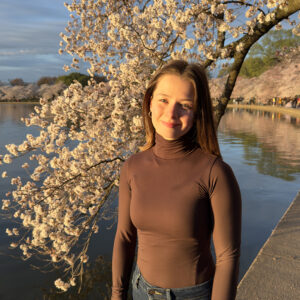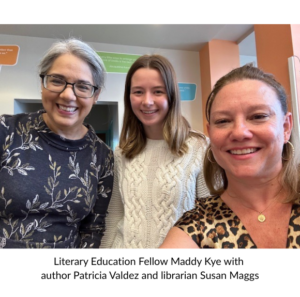 By Maddy Kye, Lisa Page Literary Education Fellow
By Maddy Kye, Lisa Page Literary Education Fellow
Over the course of this academic year, I’ve been fortunate to serve as the Writer in Residence at two schools in DC: Brightwood Elementary and Center City PCS-Brightwood. The experience has been extremely rewarding, and I’ve learned a lot about the importance of providing students with both structure and choice, aiming to guide them without limiting their creativity.
At Brightwood Elementary, I collaborated with school librarian Susan Maggs to facilitate programming for an energetic group of fourth graders. Though extremely creative, many of the students initially struggled to express their ideas in writing. In my own writing practice, I’m familiar with the difficulty of getting concepts out of my mind and onto the page, and I have learned to break the writing process down into small steps that often rely on writing prompts, templates, and generative exercises. I shared these approaches with my students.
In the beginning, I led them through a few rounds of Mad Libs, which showed them that without even trying to, they had authored a story. Next, students relied on templates to craft character introductions and write poems based on very specific guidelines. As their writing progressed, so did their creative freedom. In later sessions, students wrote stories consisting of sentences beginning with either fortunately or unfortunately in which anything could happen. In a similar vein, students paired up to write dialogues between the characters they created.
 The creativity of the students at Brightwood Elementary School really shone during the residency. It was wonderful to watch them develop new stories and poems, and also to see how their creativity manifested in other ways, including character illustrations and visual backgrounds for their poems. We wrapped up the residency with a small celebration, and to encourage students to continue honing their writing skills, PEN/Faulkner gave each student a small notebook.
The creativity of the students at Brightwood Elementary School really shone during the residency. It was wonderful to watch them develop new stories and poems, and also to see how their creativity manifested in other ways, including character illustrations and visual backgrounds for their poems. We wrapped up the residency with a small celebration, and to encourage students to continue honing their writing skills, PEN/Faulkner gave each student a small notebook.
In my residency at Center City PCS-Brightwood, which will soon be coming to a close, I have been working with Stanley Absher’s group of seventh graders. In contrast to my elementary school residency, my middle school residency has been much more free-form. Though we began with short, structured activities—learning about the importance of sensory details, mapping story structures, and testing out a generative writing prompt—we soon adjusted course so that students could devote more time to their individual ideas and projects.
Over the course of four sessions themed around writing fantasy stories, students designed characters and settings, developed and resolved central conflicts in their stories, and ultimately exchanged comments on their work with their peers. I was struck by the varied approaches students took to their work, some conforming to the expectations of the fantasy genre, and others subverting them. After our fantasy unit, we spent a few sessions focusing on character development, during which students wrote about typical days in the lives of their characters before imagining their characters in strange hypothetical situations. How might their character react when meeting a love interest? How would they fare in a haunted house?
As the residency nears its end, we’ll be switching things up and spending a few sessions writing poetry. Like fiction, poetry demands the use of strong details, and I’m really excited to see how students approach writing and revising their poems in the weeks to come.
